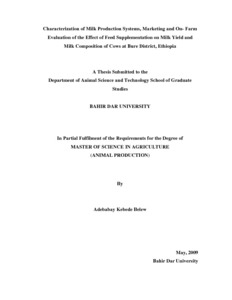Resource information
The study was conducted in Bure District of the Amhara National Regional State (ANRS) with objectives of characterizing the milk production & marketing systems and evaluating the effect of feed supplementation on milk yield & milk composition of local cows. A single-visitmultiple- subject survey was used to collect data on milk production & marketing systems. A total of 181 milk households were individually interviewed. On-farm feeding trial was conducted on twenty lactating cows of uniform parity and stage of lactation using a Randomized Complete Block Design (5 treatments & 4 replications). Average body weight and initial milk yield of cows were 231.7±36.7 kg & 1.08±0.11 kg/cow/day respectively. The treatment groups included grazing (T1), noug seed cake (T2), adlib urea treated wheat straw (T3), noug seed cake+ adlib urea treated wheat straw (T4) and concentrate comprising 74% maize grain+25% noug seed cake +1% salt (T5). From the survey, rural small-holder, periurban, and urban milk production systems were identified. Milk and butter were found to be marketed mainly through informal marketing systems. Indigenous and Fogera-Friesian crossbreds were the dominant cattle breeds. The major livestock feed resources are natural pasture, crop residues and aftermaths. Trypanosomiasis, pasteurolosis, anthrax and black leg were the major reported cattle diseases. The main problems of milk production & marketing were lack of feed, disease outbreak, lack of improved cattle breeds and distance to marketing points. The on-farm feeding trial result showed a significant difference (P<0.05) between control and supplemented group in terms of increased milk yield, milk-fat and total solids while treatment effects were not-significantly different (p>0.05), for increased milk protein, solids-not-fat and ash contents. The highest and the lowest milk yield per day was recorded for cows fed urea treated wheat straw and the control group, respectively. The intervention diets increased the net profit/cow/day by ETB 3.40 (T2), 6.33 (T3), 3.58 (T4), and 3.84(T5) over the control (T1). In general, despite the untapped milk potential of the district, the existing milk production (mainly extensive) & marketing (mainly informal) systems are found to be interwoven by many constraints. Urea treated wheat straw supplementation improved milk yield, weight gain and economic return. Therefore, further works are needed in areas of milk nutrition, health, product marketing, input delivery and services and scaling up the feeding package developed in this study considering the respective milk production systems to capitalize the market oriented milk industry in the district.



